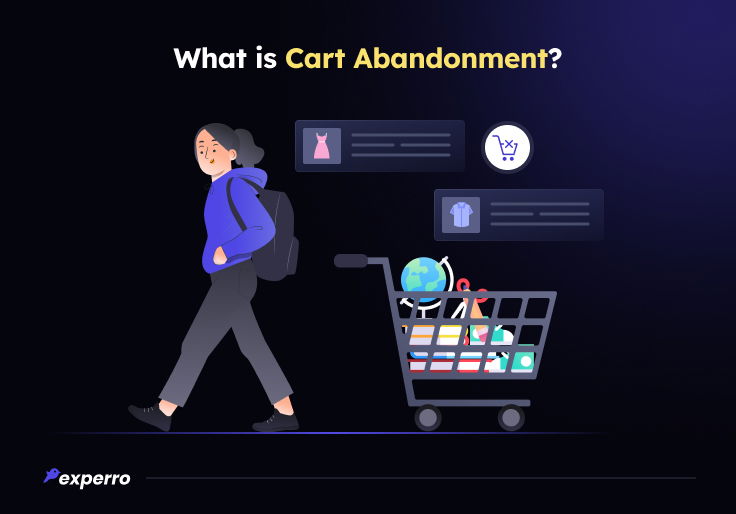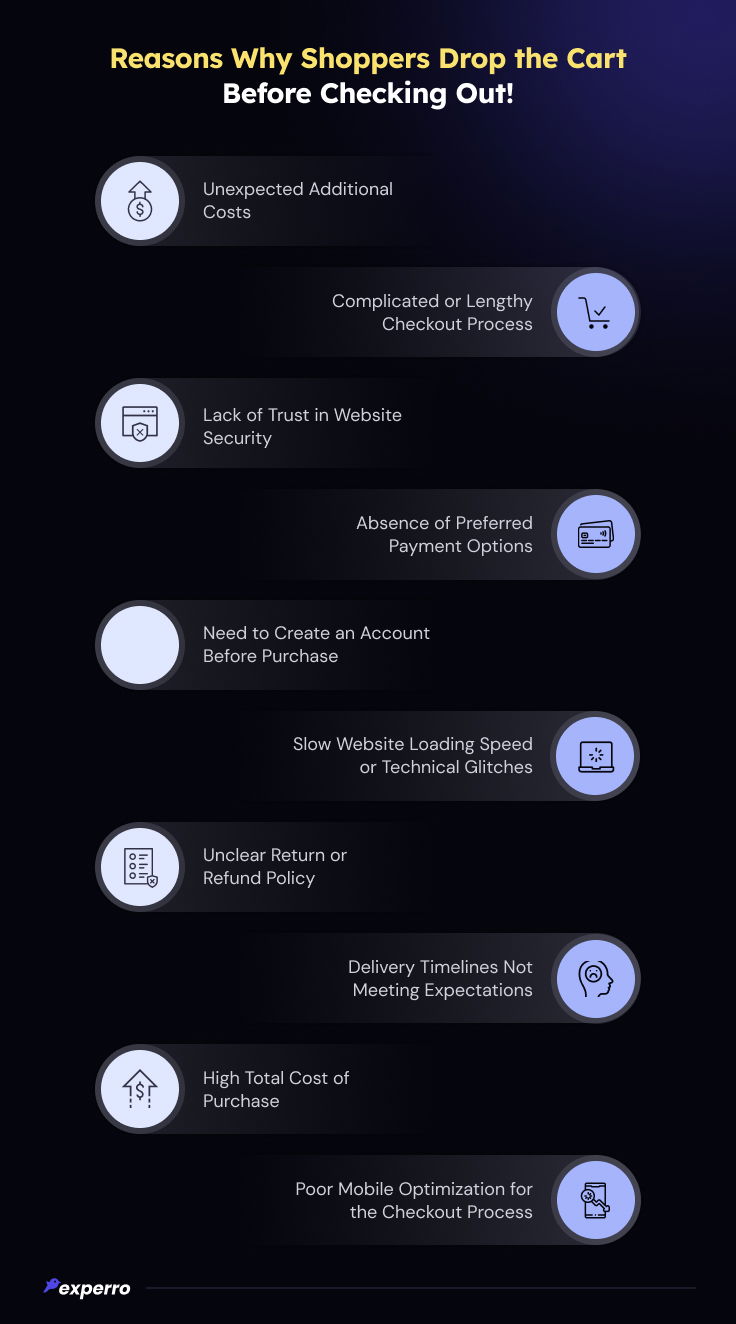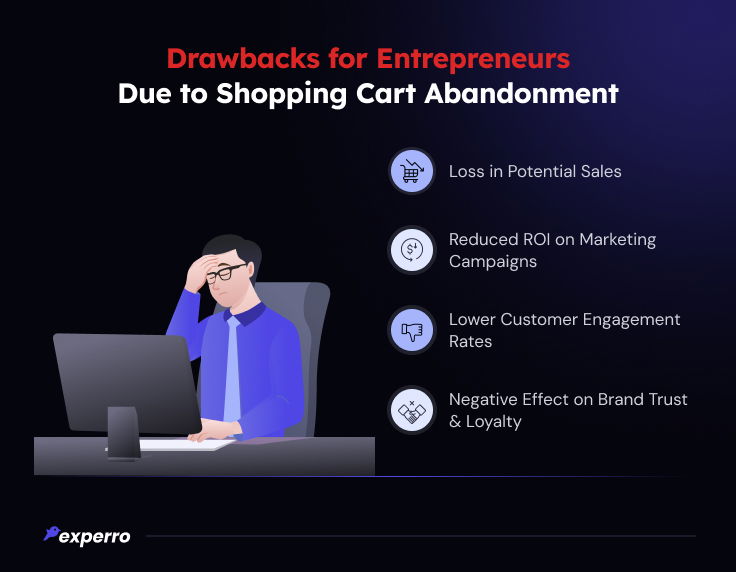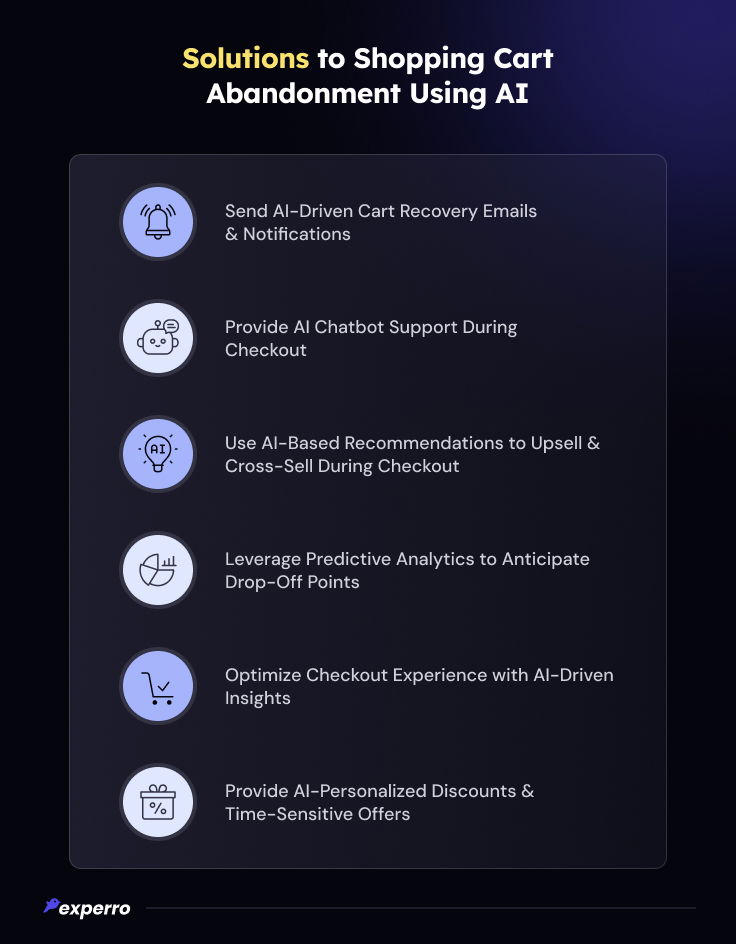Don’t Miss These Cart Abandonment Recovery Strategies for 2025!

What’s Inside
- Understanding Cart Abandonment
- What Makes Shoppers Abandon Their Carts?
- Lost Sales: The Effects of Shopping Cart Abandonment
- What Are the Solutions to Shopping Cart Abandonment Using AI?
- Measure Your Shopping Cart Abandonment Rate
- How Can Experro Help You Decrease Your Cart Abandonment Rate?
- Conclusion
Key Takeaways
- The best cart abandonment recovery solutions focus on simplifying checkout processes and ensuring transparent pricing to minimize drop-offs.
- AI-driven tools for personalized emails and recommendations effectively recover lost sales.
- Key factors like lack of trust in security, limited payment options, and poor mobile optimization often prevent shoppers from reaching the checkout stage, i.e., they abandon the carts.
- Experro’s AI-driven personalization and seamless digital experiences transform abandoned carts into completed purchases.
Did you know that over 70% of online shoppers abandon their carts before completing a purchase?
This surprising figure highlights a persistent challenge for eCommerce businesses. Online shopping cart abandonment can drastically impact sales and profitability.
To thrive in this competitive landscape, brands need effective abandoned cart recovery solutions.
With the right strategies and tools, including AI-powered eCommerce cart abandonment solutions, businesses can turn abandoned cart recovery opportunities into conversions and drive substantial growth.
Now, let’s explore what is cart abandonment.
Understanding Cart Abandonment

Cart abandonment meaning - Cart abandonment refers to a scenario where customers add products to their cart but leave without completing the purchase.
It is one of the common challenges in the eCommerce industry, leading to lost revenue and wasted marketing efforts. By understanding checkout and cart abandonment reasons, businesses can take proactive steps to mitigate this issue.
Factors like a complicated checkout process or lack of trust often discourage shoppers. With data-driven insights and cart abandonment recovery strategies, you can tackle this issue and improve your customers' shopping experience.
What Makes Shoppers Abandon Their Carts?
Checkout and abandoned cart recovery remain significant concerns for eCommerce businesses, even as online sales continue to grow.

Let’s delve into the top reasons for cart abandonment and how they hinder conversions:
1. Unexpected Additional Costs (Example Shipping, Taxes or Fees)
Do you know the #1 reason shoppers leave their carts behind? Unexpected fees, which account for 48% of abandonments. Hidden charges during checkout often catch shoppers off guard.
When faced with extra costs, many customers abandon their carts, considering the purchase unaffordable.
Transparent pricing and visible fee breakdowns are crucial to reduce shopping cart abandonment caused by surprise expenses.
2. Complicated or Lengthy Checkout Process
A tedious checkout flow frustrates users and leads to abandoned shopping carts. Every extra step increases the likelihood of abandonment.
Implementing AI-powered shopping cart optimization can simplify this process, enhancing user satisfaction and reducing drop-offs.
Streamlining navigation and reducing form fields can also significantly improve the checkout experience.
3. Lack of Trust in Website Security (Payment, Location, etc.)
Shoppers hesitate to proceed if they doubt the security of their payment information.
Trust signals like SSL certificates and secure payment badges can reassure users and improve the shopping cart conversion rate.
4. Absence of Preferred Payment Options
Modern shoppers demand flexibility. When their preferred payment method isn’t available, they’re likely to leave.
Businesses must offer diverse payment options to avoid shopping cart abandonment and cater to global audiences.
Including modern methods like digital wallets and buy-now-pay-later services can also increase conversion rates.
5. Need to Create an Account Before Purchase
Forced account creation is a major roadblock for quick buyers.
A guest checkout option can help decrease cart abandonment, enabling users to complete purchases without unnecessary steps.
Incentivizing account creation post-purchase can also boost long-term user retention.
6. Slow Website Loading Speed or Technical Glitches
Poorly optimized websites with slow load times lead to digital shopping cart abandonment.
AI-driven tools for performance monitoring and PWA eCommerce can ensure a smooth and efficient online shopping experience, minimizing shopping cart abandonment recovery.
Regular performance audits and e-store testing are critical to maintaining fast load speeds.
7. Unclear Return or Refund Policy
Ambiguity around returns or refunds makes shoppers second-guess their purchases.
Clear, customer-friendly policies can build trust and decrease the checkout abandonment rate.
Highlighting hassle-free return processes on the checkout page can reassure customers further.
8. Delivery Timelines Not Meeting Expectations
Lengthy delivery times can deter customers, particularly in industries with high competition.
Offering faster delivery options helps reduce shopping cart abandonment.
Transparency about estimated delivery dates during checkout flow also enhances trust and reduces drop-offs.
9. High Total Cost of Purchase
If the overall cost seems unreasonable, users abandon their carts. Dynamic pricing and AI-powered abandoned cart recovery strategies can provide personalized discounts to recover potential eCommerce sales.
Clearly showing costs and offering payment plans can help reduce price shock.
10. Poor Mobile Optimization for the Checkout Process
With mobile-first commerce on the rise, poorly optimized experience leads to mobile cart abandonment.
Responsive design and streamlined interfaces are essential to convert mobile users.
Prioritizing mobile-first development ensures a seamless experience for on-the-go shoppers.
Lost Sales: The Effects of Shopping Cart Abandonment
When carts are abandoned, the consequences ripple through every facet of the business.

Let’s explore the effects of cart abandonment.
1. Loss in Potential Sales
Each abandoned checkout represents a missed revenue opportunity, directly affecting business growth. Abandoned carts can be recovered and prevent some of these losses.
2. Reduced ROI on Marketing Campaigns
High abandonment rates mean marketing investments result in lower returns. Right eCommerce retargeting and abandoned cart recovery strategies are crucial to maximizing ROI.
3. Lower Customer Engagement Rates
Abandoned carts indicate disengagement. Gen AI-driven personalization and abandoned cart retargeting can reignite interest and boost conversions.
4. Negative Effect on Brand Trust and Loyalty
Frequent product abandonment after adding it to the cart can harm brand reputation, making it harder to retain the customers. Optimized shopping experiences are key to rebuilding trust.
Now, let’s dive deeper into “How to reduce cart abandonment?”
What Are the Solutions to Shopping Cart Abandonment Using AI?
AI has revolutionized the way eCommerce stores approach online shopping cart abandonment solutions.

Here’s how abandoned cart recovery can be driven:
1. Send AI-Powered Cart Recovery Emails and Notifications
Automate personalized reminders using AI to re-engage shoppers with tailored product links and exclusive offers.
AI can also determine the optimal timing for sending these reminders, ensuring they reach customers when they are most likely to act.
These emails become even more compelling by incorporating dynamic content, such as real-time product availability or trending items.
2. Provide AI Chatbot Support During Checkout
Deploy AI chatbots to assist customers in real-time, addressing queries and reducing hesitation during checkout.
These chatbots can handle common concerns, such as payment issues or shipping queries, ensuring a smoother checkout process.
With natural language search, they provide a human-like interaction, building trust and reducing drop-offs.
3. Use AI-Based Recommendations to Upsell and Cross-Sell During Checkout
Upsell meaning - Encouraging customers to purchase a higher-end version or add-on to their chosen product.
Cross-sell meaning - Suggesting complementary or related products to enhance customer’s purchase.
Digital experience analytics analyzes user behavior to suggest relevant products, improving the abandoned cart conversion rate.
These AI-based recommendations can be tailored to user preferences, purchase history, or seasonal trends.
By highlighting complementary or upgraded items, AI boosts sales and enriches the overall customer journey.
4. Leverage Predictive Analytics to Anticipate Drop-Off Points
eCommerce analytics tools analyze shopping patterns and user behaviors with the help of AI to identify stages where customers are most likely to abandon their carts.
By using heatmaps and behavioral insights, businesses can pinpoint friction points and implement tailored strategies to address them.
For instance, offering simplified payment options or faster loading times can significantly reduce abandonment.
5. Optimize Checkout Experience with AI-Driven Insights
AI tools can assess and refine the checkout process by identifying bottlenecks (such as confusing layouts or excessive steps), ensuring a seamless and user-friendly experience.
With continuous learning, generative AI in eCommerce can suggest iterative improvements, such as one-click payment options or auto-filled forms, that align with evolving customer expectations.
6. Provide AI-Personalized Discounts and Time-Sensitive Offers
Using AI for predictive customer analytics, online retailers can provide personalized discount codes or limited time offers at the right moment, creating a sense of urgency and increasing the likelihood of purchase completion.
AI can also segment customers based on their purchase history and offer tiered discounts or loyalty perks, further incentivizing them to complete their purchases.
Measure Your Shopping Cart Abandonment Rate
Formula to calculate cart abandonment rate:
(Number of Abandoned Carts ÷ Total Carts Created) × 100
Example:
If your eCommerce store had 500 carts created during a specific period, and 200 of those were abandoned without completing the purchase, the B2C cart abandonment rate would be calculated as:
(200 ÷ 500) × 100 = 40%
This cart abandonment analytics helps businesses identify patterns. It enables them to implement effective ways to leverage cart abandonment recovery strategies and improve the eCommerce basket abandonment rate.
How Can Experro Help You Decrease Your Cart Abandonment Rate?
As a digital experience platform (DXP), Experro offers effective solutions to reduce shopping cart abandonment.
Through hyper-personalization and smart recommendations, Experro enhances customer engagement and streamlines the shopping journey.
Key solutions to minimize cart abandonment rate are:
- Providing AI-driven product recommendations to re-engage customers during checkout.
- Optimizing the on-site experience to minimize friction and encourage purchase completion.
- Delivering unified, consistent experiences across all touchpoints to build trust and loyalty.
- Offering actionable insights to help businesses identify and address abandonment trends.
Experro enables businesses to transform abandoned carts into completed transactions, driving both customer satisfaction and revenue growth.
Conclusion
Shopping cart abandonment doesn’t have to be a roadblock.
By understanding the reasons for cart abandonment and implementing AI-driven solutions, your business can reduce their average cart abandonment rate.
Ready to recover lost sales and improve your conversion rates? Schedule a call for more insights and strategies today!
FAQs


Pallavi Dadhich
07 January 2025Pallavi is an ambitious author known for her expertise in crafting compelling content across various domains. Beyond her professional pursuits, Pallavi is deeply passionate about continuous learning, often immersing herself in the latest industry trends. When not weaving words, she dedicates her time to mastering graphic design.